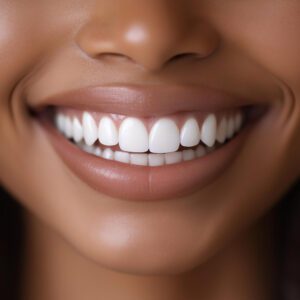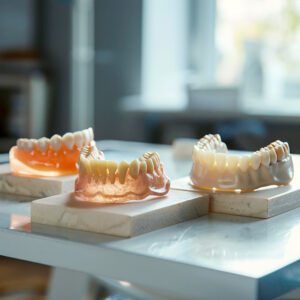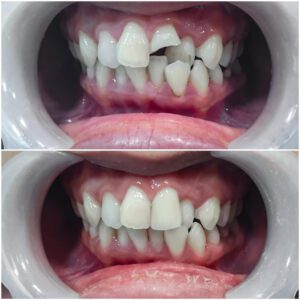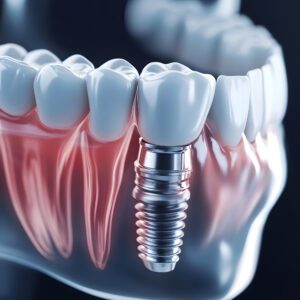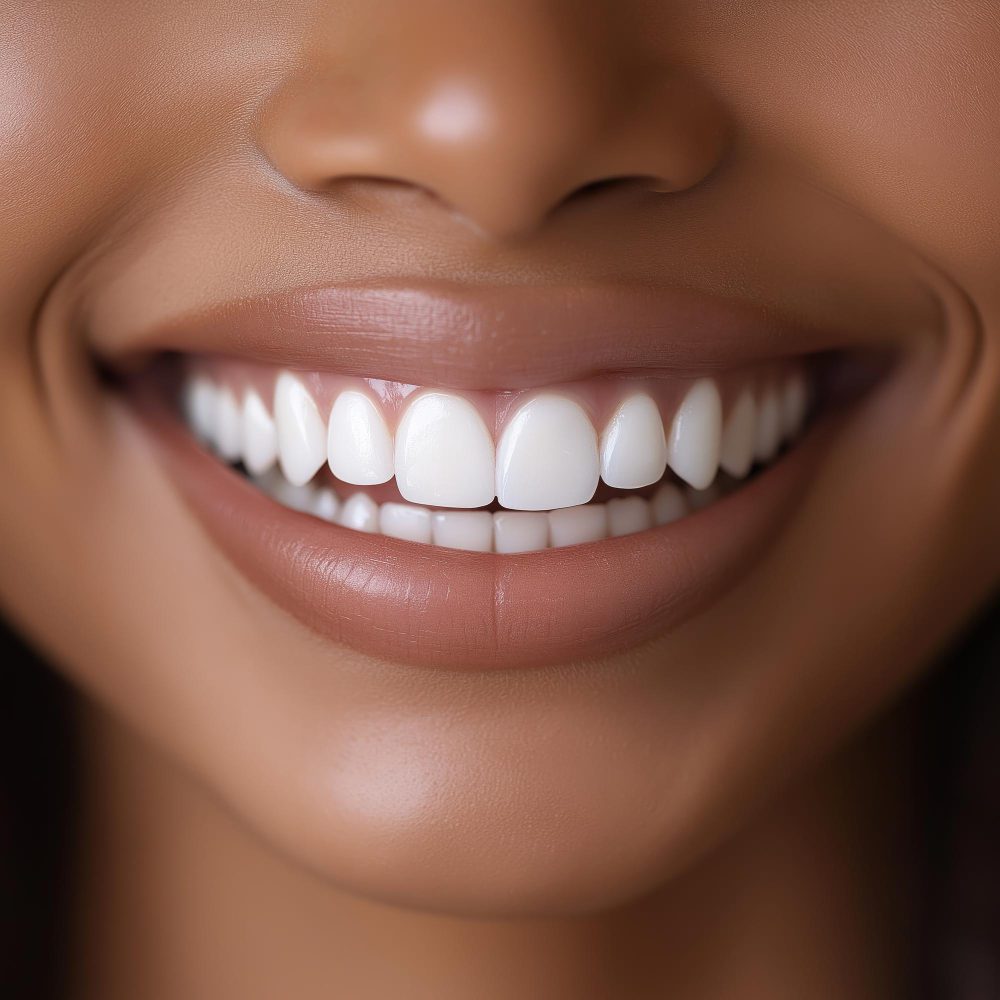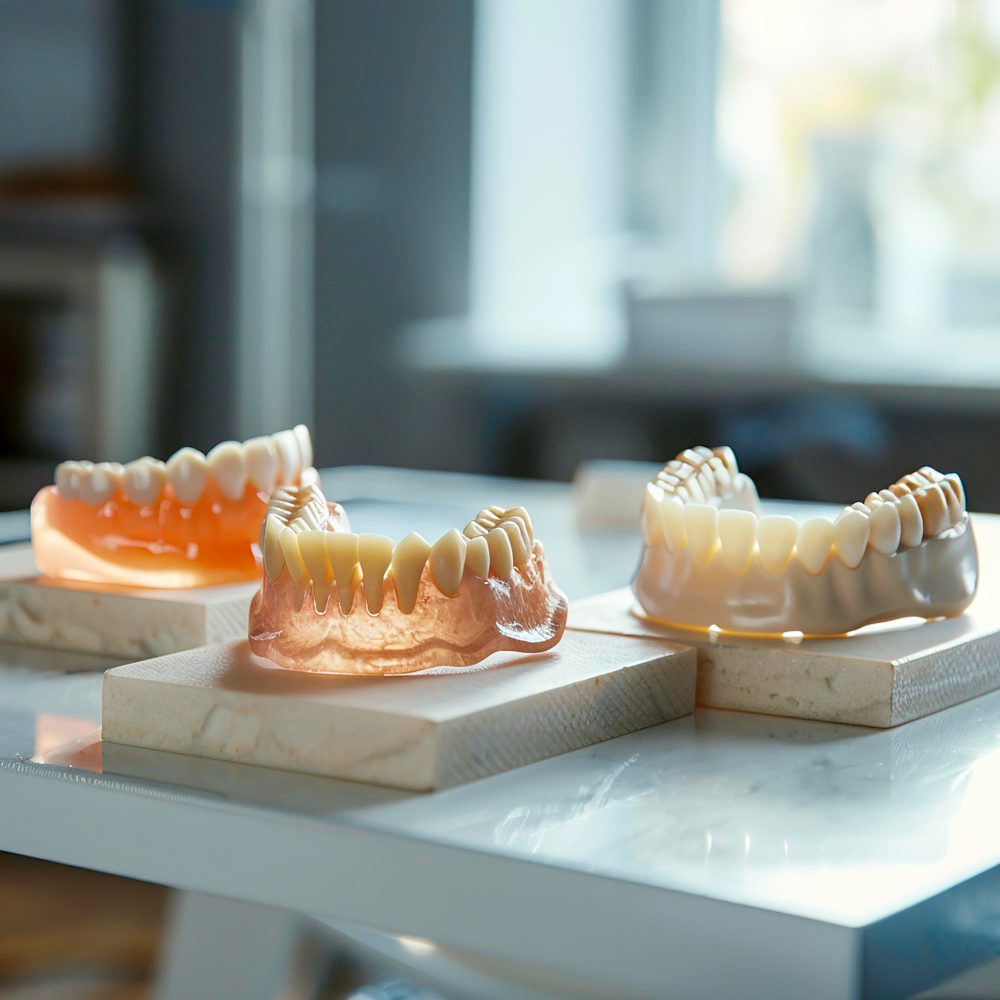What Are Veneers?
Veneers are ultra-thin shells made from durable materials, typically porcelain or composite resin, that are custom-made to cover the front surface of teeth. These dental prosthetics are designed to enhance the aesthetic appearance of a person’s smile by addressing several common dental concerns, including tooth discoloration, chips, cracks, and minor misalignment. With their intricate design, veneers provide a natural-looking finish that often surpasses the appearance of natural teeth.
The process of applying veneers typically involves several consecutive steps, beginning with a consultation with a cosmetic dentist. During this initial visit, the dentist assesses the condition of the teeth and discusses the patient’s aesthetic goals to determine whether veneers are an appropriate option. If deemed suitable, the dentist will then prepare the teeth by lightly buffing the front surface to ensure a proper fit for the veneers.
Next, impressions of the prepared teeth are taken and sent to a dental laboratory where the veneers are custom fabricated. This process usually takes about one to two weeks. In the meantime, temporary veneers may be placed to protect the prepared teeth. Once the permanent veneers are ready, the dentist will bond them to the patient’s teeth, ensuring they are properly aligned, and then curing the bonding material to secure them in place.
Overall, veneers serve an important role in cosmetic dentistry, allowing individuals to achieve a brighter, more symmetrical smile. Their applications can significantly improve self-confidence, as they provide a long-lasting solution to various dental imperfections. With advancements in dental materials and techniques, veneers continue to grow in popularity among those seeking to enhance their oral aesthetics.
Benefits of Veneers for Teeth
Veneers offer a multitude of advantages that make them an appealing option for individuals seeking to improve the aesthetic appeal of their smiles. Primarily, veneers can effectively cover imperfections such as chips, gaps, and discoloration, allowing for a more harmonious and attractive appearance. This cosmetic dentistry solution is particularly beneficial for those who desire a significant enhancement in their smile without undergoing extensive procedures.
Durability is another noteworthy benefit of veneers. Typically crafted from high-quality materials such as porcelain or composite resin, veneers can withstand the everyday wear and tear associated with normal oral activities. When properly maintained with regular dental hygiene practices, they can last several years, making them a cost-effective option in the long run. Furthermore, porcelain veneers are recognized for their stain resistance, which assists in keeping the smile looking fresh and bright over time. This feature is particularly advantageous for individuals who consume staining substances like coffee, tea, or red wine.
One of the standout characteristics of veneers is their minimally invasive nature compared to alternative dental solutions. Unlike crowns that require significantly more tooth reduction, veneers typically necessitate only a slight alteration of the dental enamel. This preserves more of the natural tooth structure, which is a key consideration for many patients. Additionally, the application process for veneers is relatively straightforward and often completed in just a few dental appointments.
Importantly, veneers can also have a profound impact on an individual’s self-confidence. A radiant smile is often correlated with self-esteem, and the aesthetic improvements provided by veneers can lead to increased social interaction and personal satisfaction. As they provide a natural look while addressing various dental imperfections, veneers are a popular choice for those aiming to boost their visual appeal and overall confidence.
Who Are Good Candidates for Veneers?
Veneers are a popular cosmetic dental solution designed to enhance the appearance of teeth. However, not everyone is an ideal candidate for this procedure. Understanding the characteristics of suitable individuals can help assess whether veneers are the right option for them. Ideally, candidates should have relatively healthy teeth with minor imperfections. Factors such as the natural teeth’s alignment, color, and overall aesthetics play a crucial role in determining candidacy. For instance, individuals seeking to address issues such as discoloration, slight gaps, or chips may find veneers to be an effective solution.
Another vital consideration involves overall oral health. Candidates should have healthy gums and a strong commitment to maintaining their oral hygiene. Those who prioritize regular dental visits and practice good brushing and flossing habits are more likely to benefit from veneers. Furthermore, individuals who have realistic aesthetic goals and understand the limitations of dental veneers are typically more satisfied with the results.
Conversely, some individuals may not be suitable candidates for veneers. For example, those with severe dental decay, gum disease, or significant orthodontic issues should focus on addressing these conditions before considering veneers. Moreover, individuals who habitually grind their teeth (a condition known as bruxism) may also face challenges with veneers, as the pressure may lead to cracks or displacements in the material.
In summary, good candidates for dental veneers are those with generally healthy teeth and gums, as well as specific cosmetic concerns they wish to address. It is essential for potential candidates to consult with a dental professional to assess their individual situations and create a tailored treatment plan that aligns with their dental health and aesthetic aspirations.
The Veneer Application Process
The journey to achieving a beautiful smile with veneers begins with a comprehensive initial consultation. During this visit, the dentist evaluates the patient’s dental health and discusses their aesthetic goals. This consultation is crucial for determining if veneers are a suitable option, as well as for devising a personalized treatment plan. Patients are encouraged to ask questions and express any concerns they may have regarding the procedure.
Following the consultation, diagnostic imaging is undertaken. This involves taking X-rays or digital scans to assess the condition of the teeth and surrounding structures. Such imaging plays a vital role in planning the veneer placement accurately. It enables the dentist to visualize how the veneers will enhance the patient’s smile while ensuring the underlying dental conditions are adequately addressed.
The next stage is tooth preparation. This step involves removing a small amount of enamel from the front surface of the teeth where the veneers will be placed. The amount of enamel removed is minimal, usually around 0.5 to 1 millimeter, allowing for a natural fit. It is during this process that some patients may experience mild discomfort, which can be effectively managed with local anesthesia or sedatives. The focus is on ensuring the patient’s comfort while preparing the teeth for the veneers.
After tooth preparation, impressions of the teeth are taken, either through traditional molds or digital scanning. These impressions are essential for creating customized veneers that align perfectly with the patient’s natural teeth. Finally, once the veneers are ready, the dentist bonds them to the teeth using a special adhesive. This final bonding process completes the veneer application, resulting in a stunning and natural-looking smile. Patients may be advised to avoid certain foods for a short period post-application to ensure optimal adhesion of the veneers.
Aftercare and Maintenance of Veneers
Once dental veneers have been successfully applied, proper aftercare and maintenance are crucial to ensure their longevity and integrity. Although veneers are designed to be robust and resilient, adhering to specific care routines can significantly enhance their lifespan. Daily oral hygiene practices form the foundation of veneer maintenance. It is imperative to continue with regular brushing and flossing techniques, ideally using a soft-bristled toothbrush and non-abrasive toothpaste. This helps to prevent plaque buildup and maintains the overall health of your gums and teeth.
In terms of dietary considerations, individuals should exercise caution with certain food items. Hard and crunchy foods, such as nuts or ice, can pose a risk of cracking or damaging the veneer material. Likewise, sticky or chewy substances, like caramel or taffy, may dislodge veneers or cause discomfort. It is recommended to cut food into smaller pieces and chew cautiously, particularly in the areas where veneers have been placed.
Moreover, it is advisable to avoid staining substances such as coffee, tea, red wine, and tobacco, which could dull the vibrant appearance of the veneers over time. Regular dental visits play a critical role in maintaining veneers. Biannual check-ups allow your dentist to monitor the condition of the veneers and address any potential issues before they escalate. During these visits, professional cleanings help remove stubborn stains and tartar, promoting both cosmetic and oral health.
In summary, the aftercare and maintenance of veneers require dedication and attention to detail. With the proper practices in place, patients can enjoy their veneers for many years, maintaining not only their aesthetic appeal but also their functional integrity.
Common Misconceptions About Veneers
Veneers are a popular cosmetic dental treatment known for their ability to enhance the appearance of teeth. However, several misconceptions about them persist, often leading to misunderstandings regarding their use and effectiveness. One prevalent myth is that veneers are extremely fragile and prone to breakage. While veneers are indeed made of porcelain or composite resin, advancements in dental technology have significantly improved their durability. When properly crafted and adhered to the tooth structure, veneers can withstand normal biting forces and last many years, often exceeding a decade with appropriate care.
Another common misconception is that veneers result in an unnaturally bright or artificial appearance. Many people fear that their smile might resemble that of a dental mannequin. In reality, skilled cosmetic dentists can tailor the color, shape, and translucency of veneers to match the patient’s natural teeth. This personalization ensures that the final result is both aesthetically pleasing and blends seamlessly with existing teeth. A professional dental evaluation can provide guidance on selecting the optimal shade for achieving a natural look.
Additionally, many individuals believe that the veneer placement process is painful. This stems from the assumption that significant tooth removal is necessary before applying veneers. While some minimal tooth reduction may be necessary, most patients report only mild discomfort, comparable to receiving a tooth filling. Dentists often offer local anesthesia to ensure the procedure is comfortable. Understanding these facts can alleviate concerns and help patients make informed decisions regarding their dental aesthetics.
It is essential to dispel these myths to foster a clearer understanding of veneers. By informing patients through accurate information and expert opinions, misconceptions can be addressed, paving the way for more individuals to consider veneers as a viable solution for enhancing their smiles.
Frequently Asked Questions About Veneers
Veneers are a popular cosmetic dental option, and potential patients often have various questions about their benefits, lifespan, and procedural details. Below, we address common inquiries to clarify this dental choice and support informed decision-making.
What is the lifespan of veneers?Typically, porcelain veneers can last between 10 to 15 years with proper care, whereas composite veneers may require replacement sooner, generally lasting 5 to 7 years. Regular oral hygiene practices, including brushing and flossing, along with routine dental check-ups, can significantly extend the lifespan of veneers, ensuring they remain in excellent condition over time.
Are there any risks involved with getting veneers?Like any dental procedure, obtaining veneers carries certain risks. These may include sensitivity to hot or cold temperatures, potential chipping of the veneer, and the possibility of needing further dental work if the tooth beneath the veneer exhibits decay. It is essential for patients to discuss these risks during consultative appointments to understand their individual circumstances fully. Moreover, ensuring the procedure is carried out by a skilled dentist can minimize potential complications.
What are the differences between porcelain and composite veneers?Porcelain veneers are known for their durability and natural appearance, making them an excellent choice for those seeking long-lasting results. They are stain-resistant and can mimic the light-reflecting properties of natural teeth effectively. Conversely, composite veneers are typically less expensive and can often be applied in a single visit. However, they may not last as long and might require more frequent touch-ups to maintain their aesthetic appeal.
How affordable are veneers?The cost of veneers can vary widely based on factors such as the type of material used, the dentist’s experience, and the clinic’s location. In Turkey, veneers are generally more affordable compared to many Western countries, making it an attractive destination for dental tourism. Patients are encouraged to seek quotes from multiple dental clinics to find options that align with their budget while ensuring quality care.
In conclusion, understanding the aspects surrounding veneers can facilitate better decision-making for individuals considering this popular cosmetic dental treatment. Addressing common questions regarding lifespan, risks, material differences, and costs ensures that prospective patients are well-informed.
Best Dental Clinics in Turkey for Veneers
Turkey has emerged as a favored destination for dental treatments, particularly for aesthetic procedures such as cosmetic veneers. Several dental clinics in Turkey are known for their remarkable services and innovative techniques in applying veneers. Notably, Dr. Abdulrahman Öztürk Clinic stands out for its patient-centered approach and emphasis on quality care. Dr. Öztürk, a highly skilled dentist with particular expertise in cosmetic dentistry, employs state-of-the-art technology to ensure optimal results. The clinic is well-reviewed for its personalized treatment plans, which are tailored to meet individual patient needs, and has garnered positive feedback for its welcoming environment.
Another highly-rated option is Dent Plus Clinic, recognized for its advanced facilities and a comprehensive range of dental services. The clinic prides itself on its team of experienced professionals who specialize in cosmetic dentistry. Dent Plus Clinic utilizes the latest techniques in veneer placement to achieve natural-looking results. Patients frequently praise the clinic for their outstanding attention to detail and thorough consultations before any procedures. Furthermore, they offer competitive pricing without compromising quality, making them a popular choice among both local and international patients.
Taksim Clinic is also a prominent name in the field of cosmetic veneers. Known for its modern infrastructure and highly qualified staff, Taksim Clinic focuses on providing excellent dental care in a comfortable setting. The clinic’s dentists are experienced in a variety of veneer procedures, ensuring that patients receive tailored solutions that enhance their smiles. Patient testimonials frequently highlight the quality of care and the commitment to achieving patient satisfaction, reinforcing Taksim Clinic’s reputation as one of Turkey’s leading dental clinics for cosmetic procedures.
Patient Testimonials and Experiences
Patient testimonials provide invaluable insights into the world of dental veneers, often revealing the transformative impact of this cosmetic procedure. Many individuals choose veneers to address a range of aesthetic concerns including discoloration, gaps between teeth, or uneven smiles. For example, Sarah, a 32-year-old marketing professional from London, shared her experience: “I had always been self-conscious about my smile. After years of considering veneers, I finally decided to go through with it. The change was remarkable, and I feel more confident in both social and professional settings.”
Here, the emotional and psychological benefits that accompany the physical transformation are highlighted. Furthermore, each testimonial typically outlines the process leading up to the decision to undergo the procedure. James, a 45-year-old father of two, explained, “I did my homework extensively before choosing veneers. I looked at numerous clinics and consulted with my dentist, who recommended the procedure as a viable option for my stained teeth. The entire journey was smoother than I anticipated.”
In addition to aesthetic improvements, many patients also mention the heightened self-esteem and social confidence gained after their procedures. For instance, Maria, a recent college graduate, remarked, “After getting my veneers, I started smiling in photos and engaging more freely in conversations. I cannot emphasize enough how much of a difference it has made in my life.” These patient testimonials illustrate a common thread: a profound sense of satisfaction post-procedure, coupled with a renewed enthusiasm for life.
The outcomes of veneer treatments can vary, but the overarching sentiment among patients is one of positivity and gratitude. As potential patients consider veneers, hearing real-life experiences can inspire confidence in their decisions and expectations for the procedure. Many have reported that the results were worth the investment, endorsing veneers as a significant enhancement to their overall appearance and self-image.



